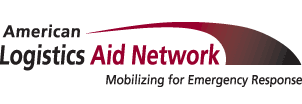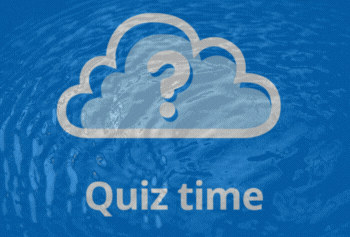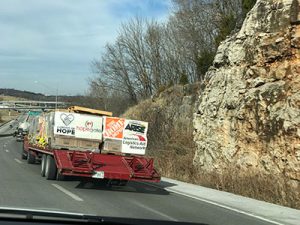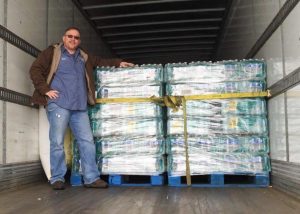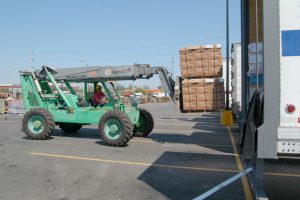April showers may be over. But it’s still raining questions here at ALAN, where we’ve just put the finishing touches on our latest “Test Your Disaster Readiness” challenge. So put on your thinking caps, get out your pretend buzzers and “wet’s” see how much you really know about flood preparation and safety.
1. How many U.S. counties have experienced at least one flood since 1998?
A. 99%
B. 55%
C. 33%
D. 22%
A
Dangerous floods can occur almost anywhere. And when they do, they can wreak serious havoc with people’s safety, health, homes and businesses. In fact, more than 40% of the country’s flood insurance claims come from people who don’t live in high-risk flood areas. So don’t assume that this type of disaster can’t happen to you or your business just because you don’t live near a lake, river or ocean. Prepare now and prepare well.
2. True or false: In the United States, floods kill more people each year than hurricanes or tornadoes.
True
If your community is experiencing a flood or the threat of one, please heed all area safety advisories, including requests to evacuate or move to higher ground. And if you happen to be on the road when flooding is present, be sure to observe the “Turn Around, Don’t Drown” rule – and stay off bridges that travel over fast-moving water. Your life could depend on it.
3. Which of the following is NOT a type of flood?
A. River floods
B. Coastal floods
C. Storm surges
D. Inland floods
E. Plain floods
F. Flash floods
E
Even if you live on a floodplain, there’s no such thing as a plain flood. However, there are many other kinds of floods – and many circumstances besides living near a body of water (including poor drainage, nearby construction projects and heavy rains) that can increase your possibility of experiencing them. To learn more about your specific flood risk levels, check out the FEMA website’s flood maps and risk assessments.
4. According to FEMA’s Ready.gov site, how many days’ worth of food, water and other supplies should an emergency preparedness kit for floods or other disasters contain?
A. One
B. Several
C. Ten
D. An unlimited number
B
While it’s certainly smart to have several weeks’ or months’ worth of supplies on hand (especially since you can always share your surplus with folks who aren’t as prepared), Ready.gov’s most recently updated baseline for an emergency kit is several days. For a full list of what types of items should go into this kit, go to that site’s Build A Kit page.
5. How much water should go into a flood emergency kit?
A. None. (For crying out loud, there’s water everywhere!)
B. Four quarts.
C. One gallon per person and pet, per day.
D. Water? What about wine, beer and soft drinks instead?
C
No matter what kind of disaster you’re dealing with, ensuring that you (and the people you’re responsible for) have clean drinking water or other forms of healthy hydration should be one of your first priorities, because none of us can survive without it for long. As for the possibility of drinking flood water instead, all we can say is “ewwwwww” – and check out question 8.
6. Which is more serious – a flood watch or a flood warning?
A. A flood watch
B. A flood warning
C. Neither. Flood watches and warnings are for worry warts.
B
A flood warning means that flooding has either been reported or it’s about to occur – and that you should take precautions at once, including getting to higher ground if you can. (And if you have a chance to turn off your building’s gas and electricity before you do, all the better.) By contrast, a flood watch means that flooding is possible and that should be ready to take action if conditions take a turn for the worse. Either way, both deserve your full attention.
7. True or False: If you own a large SUV, van or truck, you don’t have to follow the “Turn Around, Don’t Drown” rule while driving during a flood.
False
While it takes a bit more flood water to overwhelm larger vehicles, the operative term is “a bit more.” According to the NOAA, just 12 inches of fast-moving water can carry away a small car, while 18 to 24 inches of fast-moving water can do the same thing to an SUV, van or truck. Plus, it’s not always possible to tell just how deep flood water is by looking at it. So please don’t take any chances with your safety while driving around during or after a flood. Most flood fatalities occur in vehicles, and we don’t want you to become the latest statistic.
8. Why shouldn’t you drink or swim in floodwater?
A. It may contain chemicals, sewage or other forms of dangerous debris.
B. It’s so fast-moving that you could drown.
C. It could be full of snakes, rodents and other types of animals.
D. It could be covering up live power lines, which puts you at risk for electric shock.
E. All of the above.
E
According to the CDC, drinking or coming into contact with floodwaters can cause everything from E.Coli and Salmonella to wound infections, tetanus and skin infections. Add in the possibility of drowning (it only takes six inches of fast-moving water to knock adults off their feet), electrocution and encountering reptiles, and you can understand why safety officials would prefer you give floodwaters a wide berth and carefully sterilize anything they’ve touched.
9. True or false: If you’re trapped in a building that has started to flood, you should move to the building’s highest level – unless it’s a closed attic.
True
Safety experts advise against climbing into a closed attic because rising floodwaters may wind up trapping you in there. If necessary – and only then – go onto the roof instead and signal for help.
10. Fill in the blank: Many items that are donated to product collection drives wind up in ____ rather than flood survivors’ hands.
A. Landfills
B. Boise
C. Etsy shops
D. Their original location
A
Sadly, even some of the most practical items that people donate to post-flood (and other) product collection drives often go to waste. The reasons for this are myriad, which is why we encourage you to read Collection Driving Me Crazy for more details – and to consider making a financial donation or in-kind logistics offer to help with flood relief efforts instead.
11. Which of the following offers free resources for monitoring floods or their supply chain impacts?
A. The National Oceanic And Atmospheric Administration Weather Radio
B. Your local National Weather Service forecast
C. Wireless Emergency Alerts
D. Weather alerts from the FEMA app
E. ALAN’s Supply Chain Intelligence Center
F. All of the above
F
The NOAA and your local National Weather Service forecast are great resources for flood condition predictions, advisories and updates. Additionally, the FEMA app allows you to sign up for weather alerts for as many as five locations nationwide, while ALAN’s Supply Chain Intelligence Center offers detailed real-time updates about floods’ effects on roadways, ports, and airports. Make plans to use one or more of them regularly, and let us know what else we can do to help you and your company become more disaster-ready. Donate - American Logistics Aid Network (alanaid.org)
How did you score? Was it harder than anticipated? If you have any questions, reach out to us today. Our team would be happy to pass along additional flood safety and preparedness information.
Thanks for playing – and stay safe this Hurricane Season!
